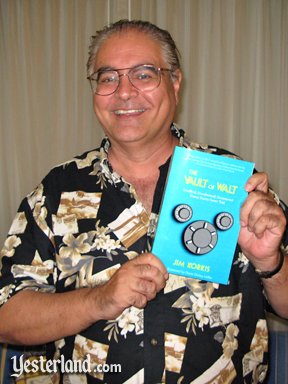|
IMAGINEERING |
The Carthay Circle Theatres (plural) at Disney’s Hollywood Studios Park |
||
|
|
|||
|
The real Carthay Circle Theatre in Los Angeles has been gone since 1969. The magnificent theater was razed to make way for a bland office building. A replica is under construction at Disney California Adventure park. The Mission Revival style theater building is the perfect focal point for Buena Vista Street, an idealized Los Angeles neighborhood of the 1920s. This isn’t the first time that Disney’s Imagineers have paid tribute to the Carthay Circle Theatre. Today, we’ll discuss not just one—but several—tributes to this historic movie palace at Disney’s Hollywood Studios at Walt Disney World with Disney historian Jim Korkis.
|
|||
|
|
|||
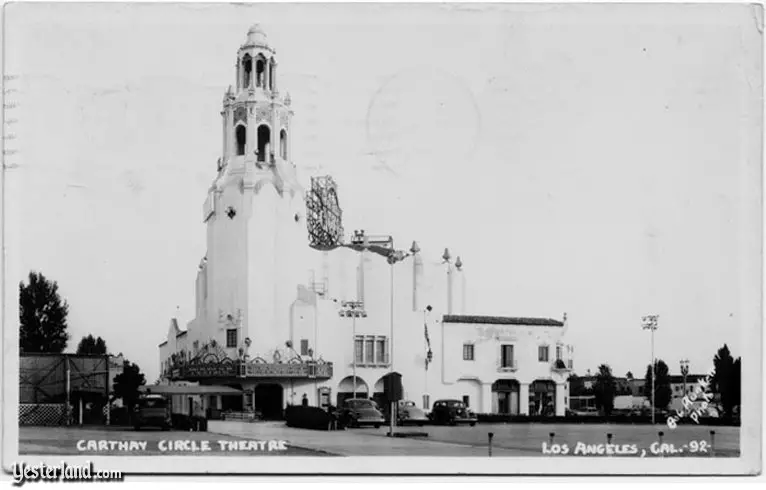
A postcard of the Carthay Circle Theatre in Los Angeles (from the collection of the California State Library) |
|||
|
The Fox Carthay Circle Theatre opened in 1926. During much of its forty years of operation, it was arguably second only to Grauman’s Chinese Theatre for movie premieres and Los Angeles area exclusive engagements of the biggest movies of those decades. Times change. In his column of June 22, 1969, Matt Weinstock of the Los Angeles Times wrote, “Dedicated landmark watchers may be disquieted to learn that the Carthay Circle Theatre isn’t there anymore.” The demolition crew had finished its work the prior week. “In today’s economy,” explained Weinstock, “the Carthay was simply not economically feasible.” National General Corporation, which owned the Fox theater chain at that time, decided it would be more profitable to build a second five-story office building adjacent to a similar building they had built a few years earlier on the other half of the Carthay Circle property. The site in a residential neighborhood at 6316 San Vicente Blvd. is approximately one half mile southwest of Hancock Park, home of the La Brea Tar Pits and the Los Angeles County Museum of Art. |
|||
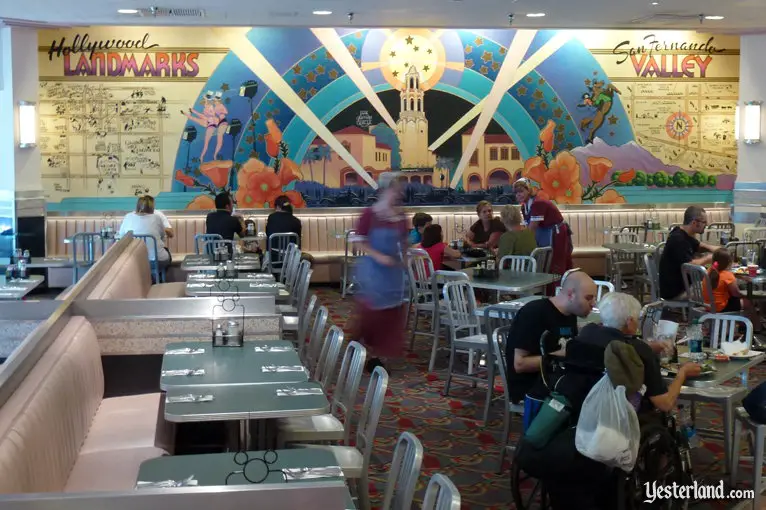
Hollywood & Vine restaurant at DIsney’s Hollywood Studios (2011 photo) |
|||
|
At least the Carthay Circle went out on a high note. During its final half year of operation, the theater presented the exclusive, reserved-seat Los Angeles engagement of The Shoes of the Fisherman, starring Anthony Quinn as the first Pope from Russia. The movie was set in the future—the late 1980s. When the actual late 1980s occurred, The Walt Disney Company was building Disney-MGM Studios (now Disney’s Hollywood Studios) at Walt Disney World. The Imagineers who worked on the park demonstrated a special fondness for the Fox Carthay Circle Theatre. |
|||
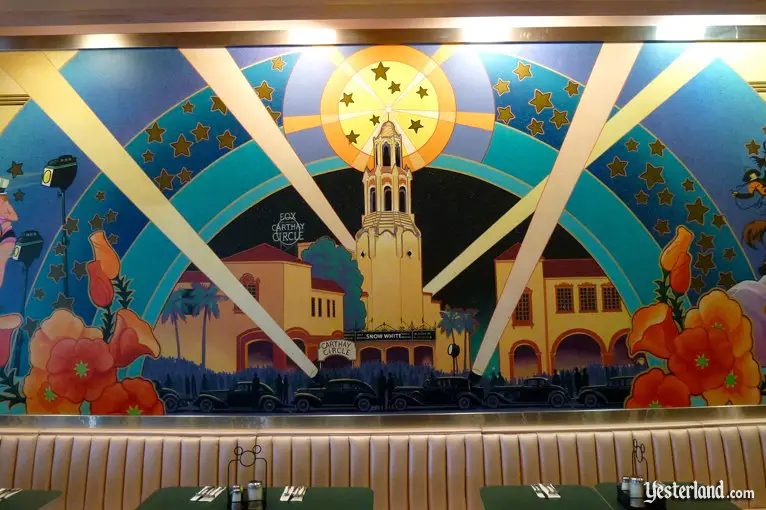
Carthay Circle Theatre mural at the Hollywood & Vine restaurant (2011 photo) |
|||
|
The Hollywood & Vine restaurant has been there since the park opened in May 1989. An interior mural features the Carthay Circle as its centerpiece. The Imagineers could have picked any landmark from the early days of the Hollywood movie industry, but they picked the Carthay Circle. Another original feature of the park, the studio gate—which originally had the Disney-MGM Studios logo and now has the Disney’s Hollywood Studios logo—also pays tribute to the Carthay Circle Theatre. There’s an identical bas relief of movie industry people, places, and objects around each of the smaller portals that flank the main portal. The Carthay Circle tower is in the upper left corner on each bas relief. |
|||
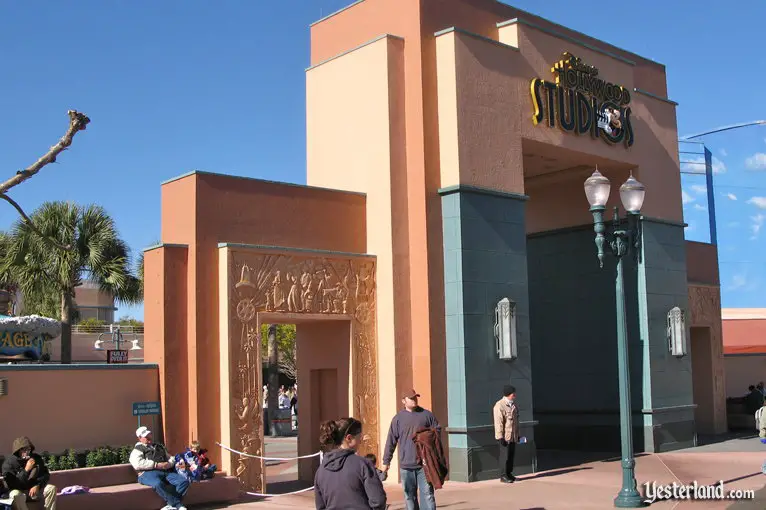
Studio gate leading to the Animation Courtyard (2009 photo) |
|||
|
In July 1994, the park grew with the addition of Sunset Blvd. The new street included four movie theater façades. One of these, the Legends of Hollywood store (modeled after the Academy Theatre in Inglewood, California), has a mural showing the four façades. A fifth theater, Grauman’s Chinese, is in the center of the mural. The row of theaters begins at the left with the Carthay Circle and its distinctive tower. At the other end of the park’s Sunset Blvd., a “shrink and edit” version of the Carthay Circle Theatre faces the Twilight Zone Tower of Terror. This Carthay Circle is much smaller than the departed movie house had been, but it’s the largest Disney tribute to it at this park. At Disney California Adventure, the Carthay Circle Theatre is significantly larger. |
|||
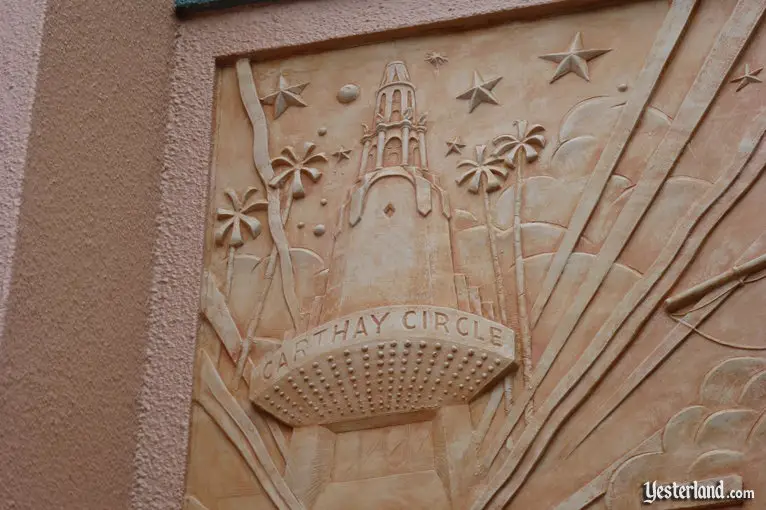
Bas relief detail showing the Carthay Circle Theatre tower (2011 photo) |
|||
|
The homage to the Carthay Circle does not end with the façade. It continues inside. Although it’s a clothing store, not a movie theater, the architectural details and lighting fixtures are all in the spirit of the original theater’s interior. There’s even a tribute to the star-studded premiere of Snow White and the Seven Dwarfs at the Carthay Circle on December 21, 1937, with historic photographs and audio. The premiere of Snow White is just one of connections between Walt Disney and the Carthay Circle. There are others, and it’s undoubtedly these connections that explain why Disney’s Imagineers care so much about the Carthay Circle. |
|||
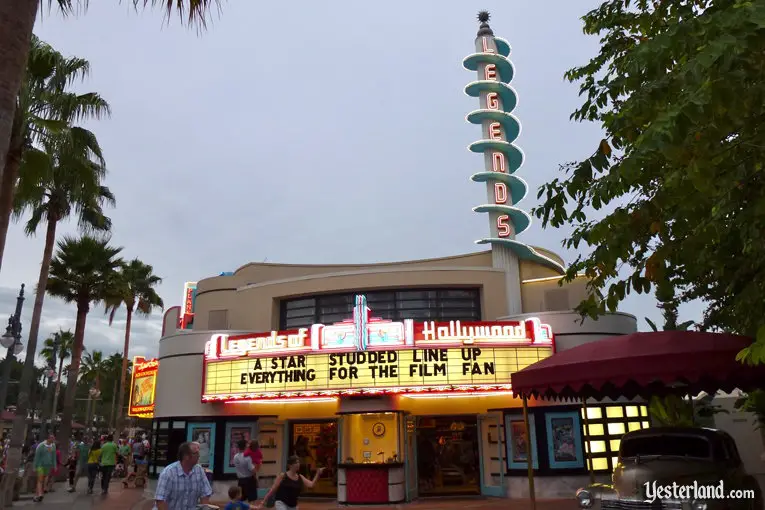
Legends of Hollywood at Disney’s Hollywood Studios (2011 photo) |
|||
|
To learn more about these connections, as well as more about the history of the Carthay Circle Theatre, I turned to Disney historian Jim Korkis. Werner Weiss: Hi Jim! The Carthay Circle Theatre was one of many large movie houses in Los Angeles, and its location south of Wilshire Blvd. was some distance from the big movie houses of Hollywood Blvd. What made the Carthay Circle special? Jim Korkis: The Carthay Circle was one of those iconic movie palaces that looked almost like a classic Spanish castle with an interior that had a somewhat unique circle design for seating. It was a beautiful, elegant theater and at night, its enormous neon sign and the floodlights illuminating the arches made it look like something out of a fairy tale. |
|||
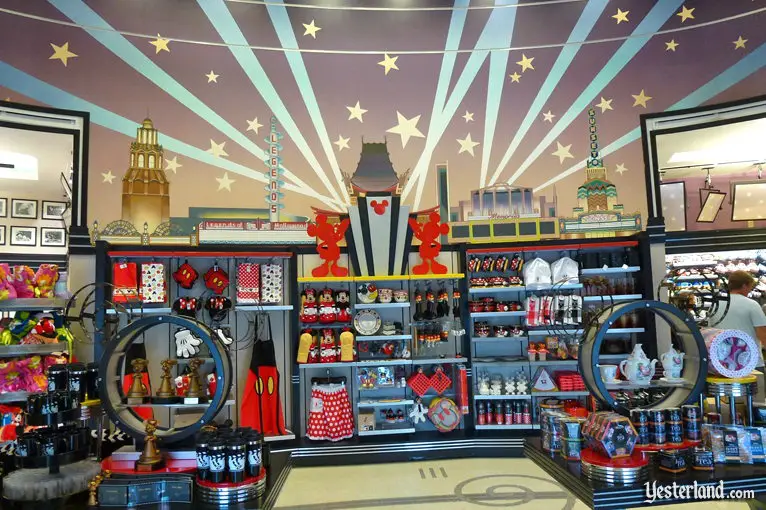
Mural in Legends of Hollywood (2011 photo) |
|||
|
Werner: How did the connection between Walt Disney and the Carthay Circle first develop? Jim: Of course, the theater showed the early Mickey Mouse cartoons before some of its feature films. In 1929, Walt’s film distributor Pat Powers refused to distribute the first Silly Symphony cartoon, The Skeleton Dance, because he felt the subject matter was too gruesome. Walt knew if he could get the short shown in a prestigious theater that an audience would love it. Walt found a salesman he knew at a local pool hall and convinced him to contact Fred Miller, the manager of the Carthay Circle Theatre, and gave him a print of the film. Miller liked it and booked it into the theater in August 1929 where it was a huge hit. Walt sent the reviews back to Powers and the short was eventually booked into New York’ Roxy Theatre where it launched the successful Silly Symphony series. |
|||
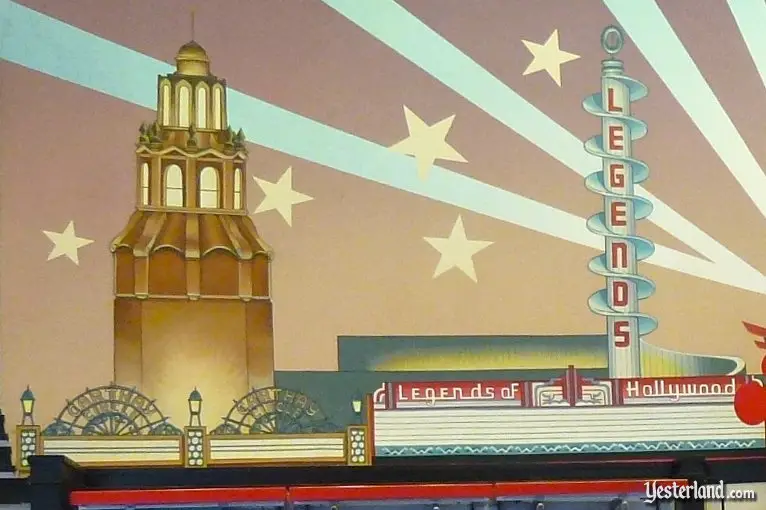
Legends of Hollywood mural detail showing the Carthay Circle Theatre (2011 photo) |
|||
|
Werner: The premiere of Snow White and the Seven Dwarfs was a huge milestone for Walt Disney. What was the premiere like? Jim: As Walt said during an interview, “All the Hollywood brass turned out for my cartoon!” Those celebrities included Marlene Dietrich, Shirley Temple, Charlie Chaplin with Paulette Goddard, Clark Gable with Carol Lombard, Judy Garland, Charles Laughton with Elsa Lanchester, Jack Benny, Burns and Allen, Cary Grant, and many others. It is funny watching the newsreels because they don’t look happy to be attending a cartoon premiere, but that attitude soon changed after they saw it. They loved it! Tens of thousands of people gathered outside on that cool starlit December night—December 21, 1937—to catch a glimpse of these celebrities and others who paid the outrageous price of five bucks to see the debut that had been sold out many days beforehand. It was an elaborate premiere with newsreel photographers, radio interviewers and more, including an outdoor display explaining the making of the film with all those wonderful pieces of original artwork and cels exposed to the weather for weeks and weeks. At the premiere, it was Disney’s first attempt at costumed characters—the Seven Dwarfs, as well as Mickey, Minnie and Donald—to mingle with the guests. Usherettes wore Snow White costumes. This was all a pretty big deal. Also, there was a Snow White Island (a median strip) almost 900 feet long, and on this was built a ten-foot-high cottage of the Seven Dwarfs, a diamond mine, a mill, a garden, and more. It cost nearly $10,000 to erect, and bills for lighting and four watchmen—because souvenir hunters were a constant menace—ran $6,500. For the premiere, there were costumed performers as the dwarfs, but for most of the rest of the run of the film, they were replaced by concrete figures. |
|||
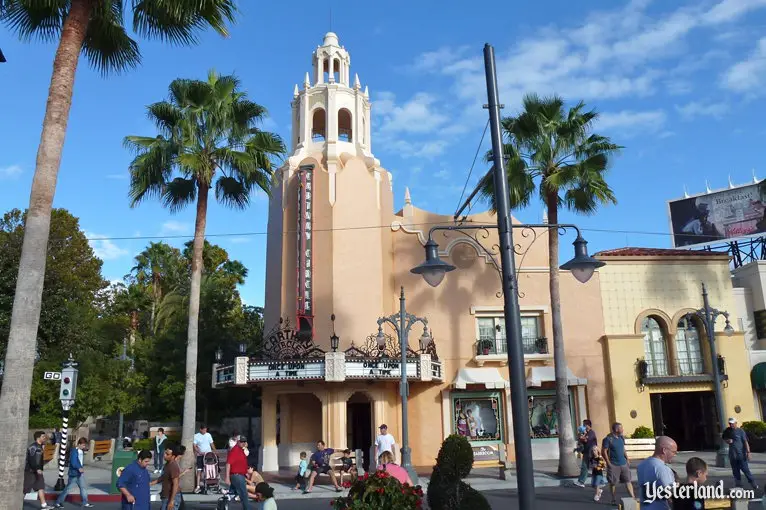
“Shrink and edit” version of the Carthay Circle at Disney’s Hollywood Studios (2011 photo) |
|||
|
Werner: I was surprised to learn that the Carthay Circle also presented a Spanish language version of Snow White and the Seven Dwarfs. Can you tell me more? Jim: Snow White played at the Carthay Circle for four months beginning December 1937. The Spanish-language edition of the feature, Blanca Nieves y los Siete Enanos, was unveiled at the Carthay Circle on Sunday, February 27, 1938, and became a regular Sunday at five o’clock feature during the remainder of the run of Snow White there, supposedly “for the benefit of Spanish students and Spanish speaking residents of this locality,” according to a Los Angeles Times article dated March 2, 1938. |
|||
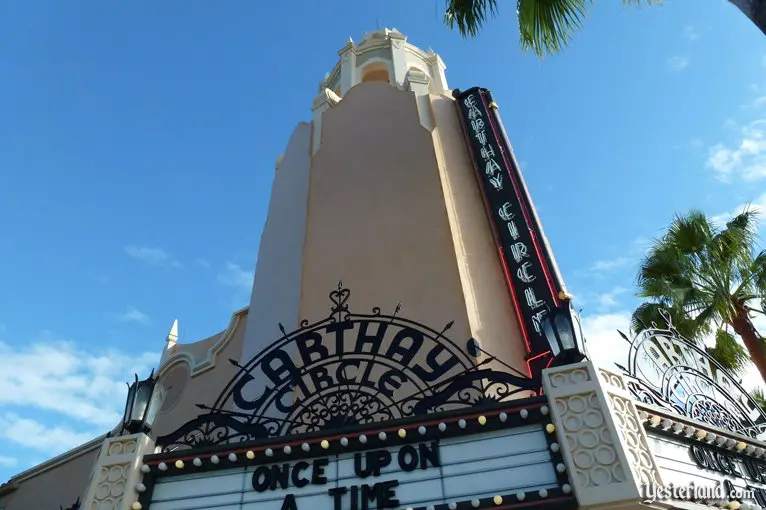
Tower of the Carthay Circle Theatre at Disney’s Hollywood Studios (2011 photo) |
|||
|
Werner: Another big Walt Disney premiere at the Carthay Circle was Fantasia in 1940. Jim: The Carthay was only one of thirteen theaters to be fitted with the full Fantasound equipment for the road show premiere of Fantasia. Actually most of those locations were legitimate theater houses like the Geary in San Francisco. The Carthay gave free tours to interested patrons so they could understand how Fantasound was supposed to work. While we think of the film as a failure at the time, it actually ran at the Carthay for 39 weeks—beating the previous record held by Gone with the Wind, which was 28. That was a good thing because initially the theater had to be closed for several days for Disney technicians to install the new system which was packed in 45 cases and weighed almost 15,000 pounds in total. |
|||
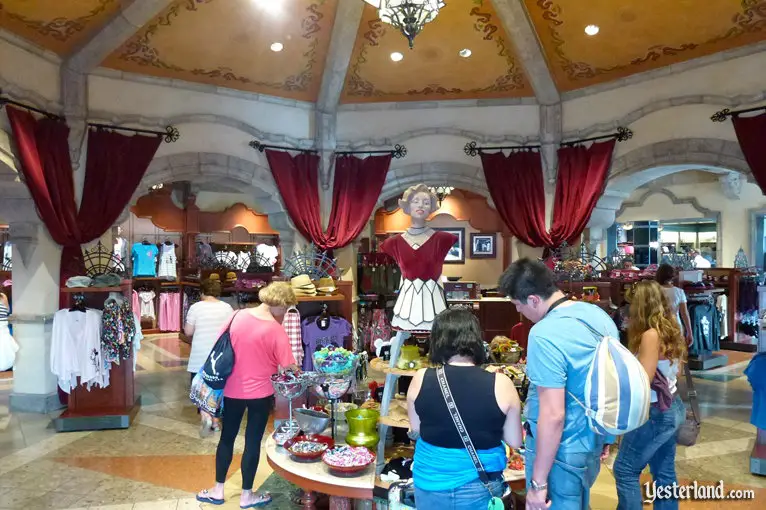
Once Upon a Time shop inside the Carthay Circle Theatre at Disney’s Hollywood Studios (2011 photo) |
|||
|
Werner: What other stories do you have about Disney and the Carthay Circle? Jim: One morning, Warner Bros. animation legend Friz Freleng, who was working on the Oswald the Lucky Rabbit cartoons for Walt Disney at the time, woke up to find a small but painful boil on his rear end so he phoned in sick to the Disney Studio. Friz decided the best way to take his mind off his pain was to take an open-air, double-decker bus to see a movie at the Carthay Circle. He thought the soft seats and air conditioning might help. At a stop light, he looked down and there was an angry Walt Disney in his Moon Roadster. He thought Friz had lied about being sick and was just goofing off, so Friz was let go from the Disney Brothers Cartoon Studio. |
|||
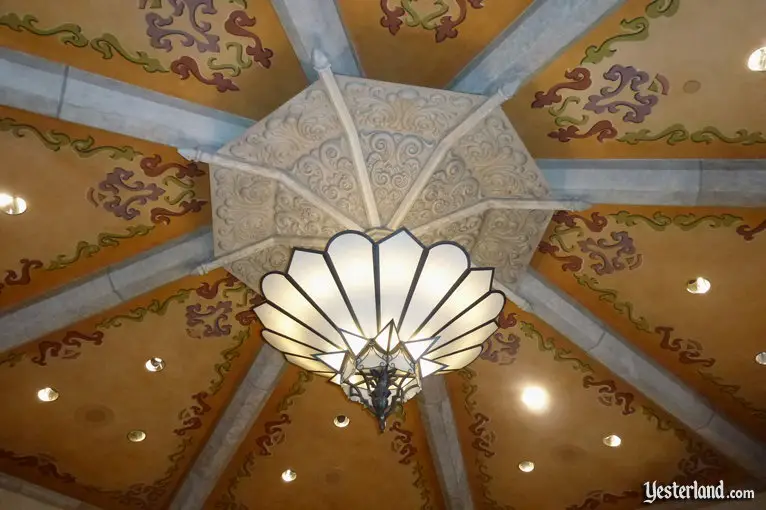
Central ceiling fixture inside the Carthay Circle Theatre at Disney’s Hollywood Studios (2011 photo) |
|||
|
Werner: I’ve read that in the 1950s, the Carthay Circle presented live theater performances. Jim: In the 50s, audiences were staying home and watching television, so many movie theaters like the Carthay Circle were transformed into legitimate stage theaters. The Carthay generally featured plays produced by Henry Duffy, who had run a major West Coast string of legit theatres in the 1920s and 30s. In 1955, there was the actual death onstage of 47-year-old actress Isabel Bonner during a hospital bed scene in the play, The Shrike. Magic shows were also staged at the Carthay, and the first PATSY awards. In the 1953 season, Basil Rathbone performed in a stage version of Sherlock Holmes, adapted by his wife, Ouida Rathbone. |
|||
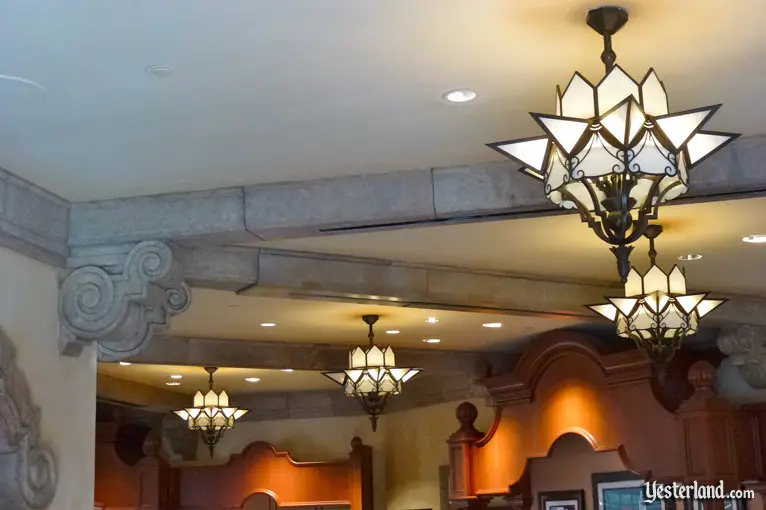
Other lighting fixtures and details in the spirit of the interior of the real Carthay Circle Theatre (2011 photo) |
|||
|
Werner: It’s too bad we never had a chance to visit the Carthay. Jim: Fortunately, the Carthay Circle Theater was itself a movie star, so some glimpses of it exist in a few Hollywood films. You can get a good look of what it looked like during the time of Snow White in the first five minutes of the 1940 Our Gang comedy, The Big Premiere. It also appears as well in the movies Hollywood Hotel (1937) with Dick Powell, The Comic (1969) with Dick Van Dyke, and the renovated interior in Caprice (1967) with Doris Day, where she falls off the balcony. |
|||
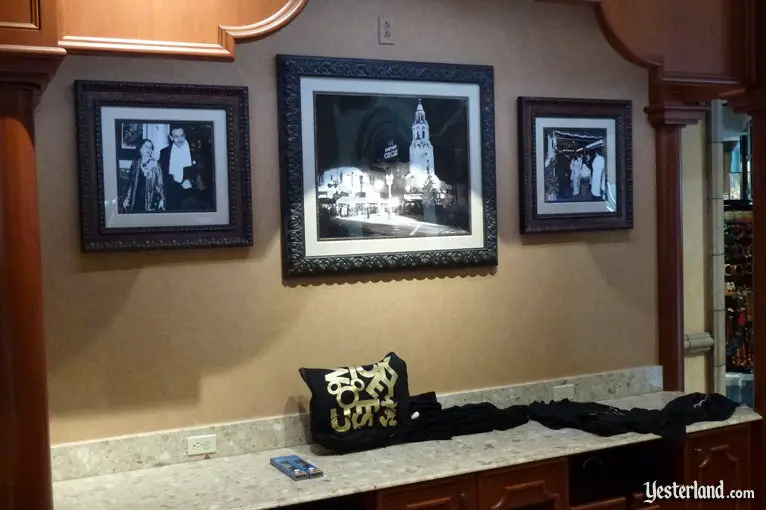
Tribute to the premiere of Snow White and the Seven Dwarfs inside the store (2011 photo) |
|||
|
Werner: Any other Carthay secrets you’d like to share? Jim: Just to compliment you on your always excellent photographic documentation. I doubt many of your readers know of all the “Hidden Carthay Theater” references at Disney’s Hollywood Studios, but these photos put all those “Hidden Mickey” hunters to shame. |
|||
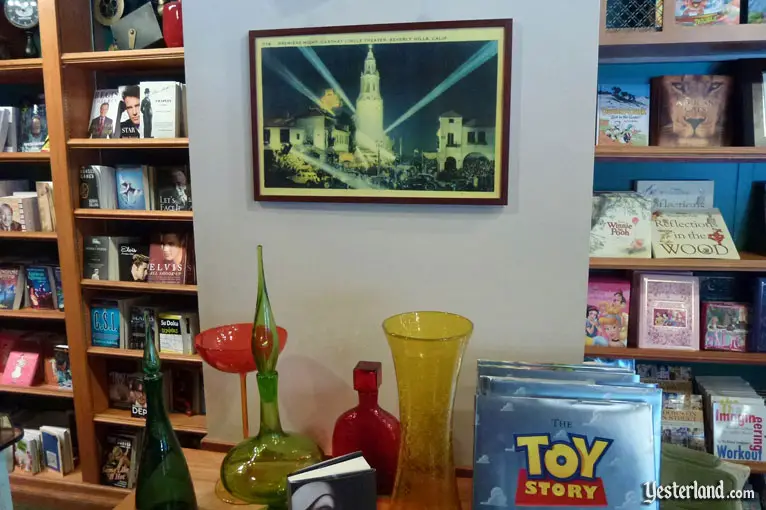
Carthay Circle Theatre photo in The Writer’s Stop near Sci-Fi Dine-In Theater |
|||
|
Werner: Now, turning to Disney California Adventure, do you think the Carthay Circle is a good choice to replace the Sun Icon? Jim: I think it is an excellent choice, not only because it honors Hollywood history but also because of its close connection to Disney heritage. I would say it is almost a vintage Hollywood version of a Disney theme park castle. |
|||
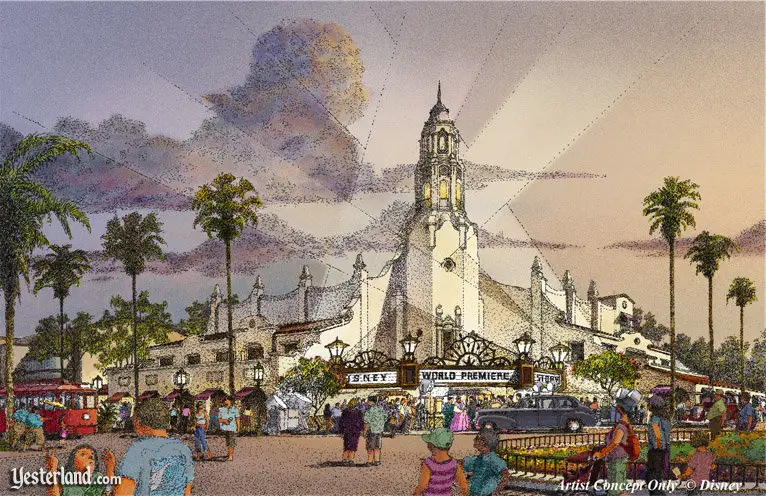
Concept for the Carthay Circle Theatre at Disney California Adventure © Disney |
|||
|
Werner: Thank you! Jim: Thank you, Werner, for your dedication to original research, your commitment to accuracy and your desire to preserve these types of stories. Yesterland has been one of my favorite sites for many years. |
|||
|
|||
© 2012 Werner Weiss — Disclaimers, Copyright, and Trademarks Updated November 3, 2012.
Historical postcard of the Carthay Circle Theatre from the collection of the California State Library. |
|||
